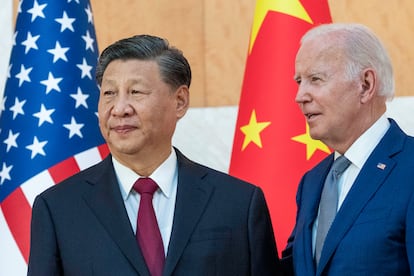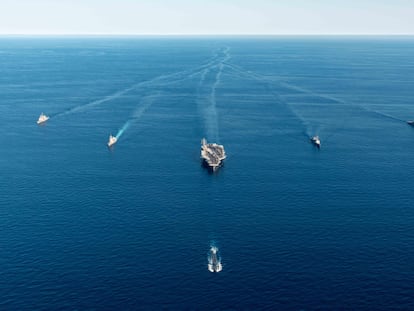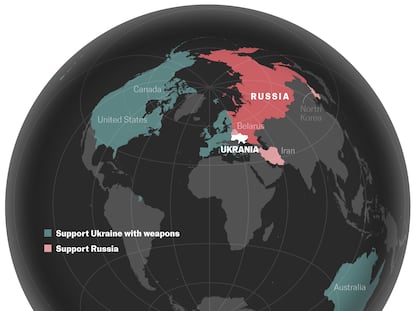How the changing balance of power is shaking up the world
The technological revolution and the shift in global relations are key factors in the destabilization of the planet. Our times are marked by new, devastating wars and dangerous power struggles

Devastating wars, dangerous tensions and disruptive changes. The world is going through a phase of turbulent international relations, as evidenced by the invasion of Ukraine, the conflict between Hamas and Israel or the stark competition between the United States and China, whose leaders — Joe Biden and Xi Jinping — are about to meet this Wednesday in California. Despite the encouraging signs with which it began, the century has gone awry. What happened?
Several factors have contributed to this great destabilization. A particularly essential one has been the profound and rapid change in the balances of international power, with the dizzying rise of China, a Russia that has recovered strength after the collapse of the 1990s, emerging nations in the Global South and a West that is losing influence.
This reconfiguration of balances — as rapid as anything that has happened in the times that we live in — has spurred new assertions of national interests, demands for change in the world order (be it via military, political or economic power) and forceful reactions. In parallel, other global destabilizing phenomena have occurred, such as the astonishing technological revolution— through social media and artificial intelligence — or climate change. Then, there are specific relevant issues, such as the troubles of democracies, which suffer from problems such as populism and ineffectiveness, elevating leaders who contribute to the global uproar (like Donald Trump).
Faced with this turbulent scenario, the international institutions that should be managing these conflicts have shown themselves to have very serious limitations. As a result, they, too, have been subject to demands for change.
The outlook is bleak… but not all paths lead to the abyss. Something else has compensated (at least a little bit) for these troubles: a previously unimaginable level of interdependence. The war launched by Russia shows that this cannot necessarily prevent disruptive actions... but it’s undoubtedly an element of containment. The meeting between Biden and Xi is a symbol of how that interdependence is a powerful stimulus to understanding.
Below, EL PAÍS has taken a look at this geopolitical moment through the points of view of some experts. Some — such as Ivo Daalder, CEO of the Chicago Council on Global Affairs and former U.S. ambassador to NATO — believe that “this is the most dangerous moment since the end of the Cold War, possibly since the Cuban Missile Crisis.” Others avoid making comparisons, but agree on the potentially high risks at this time of instability.
The shift in the global balance of power
The world entered the 21st century with democracy expanding globally. By the end of the 1990s, there was an understanding between NATO and Russia, China was preparing to enter the WTO and the Israeli-Palestinian conflict saw the signing of the Oslo Accords.
However, a series of abrupt turns quickly changed the global panorama throughout the course of this century. Bush Jr.’s reaction to 9/11 plunged the United States into two drawn-out wars — the occupation of Afghanistan and the illegal invasion of Iraq — which wore out its military and drained its resources. Then, the 2008 financial crisis dealt a terrible blow to the American and European economies. Meanwhile, China has been growing at exorbitant rates, Russia has rebuilt itself after the collapse of the 1990s, Iran has solidified its power in the Middle East and India has accelerated, while the Israelis turned their backs on any negotiations with Palestinians, as the world became incredibly disinterested with the issue. This series of events has caused a transition from a unipolar scenario— with the United States as the undisputed global superpower, dominant among its Western allies — to an agitated, assertive and multipolar order.
“We are, undoubtedly, witnessing a turning point in international relations,” says Harsh V. Pant, Vice President (Studies and Foreign Policy) at the Indian think tank Observer Research Foundation. “There’s a lot of lag in the system, a lack of clarity about the direction in which the world order is evolving. The balance of power changes very quickly, almost in an instant. Several latent conflicts have surfaced. Everything becomes less predictable and, therefore, fear emerges, because when there’s uncertainty about the future, people get scared,” the expert tells EL PAÍS.
“We’re in a moment of reaffirmation of powers and power,” reflects Pol Morillas, director of the Barcelona Center for International Affairs. “Large or medium powers understand that we’ve entered a new phase of the international order, in which we must promote a decisive safeguarding of national interests, [by distributing] the maximum quotas of hard or soft power.”
“For the first time since the end of the Cold War — perhaps since the Cuban Missile Crisis — there’s growing distrust between the major powers. Especially between China and the United States,” Daalder says. “We’re witnessing a strategic competition between a United States that is seeking to maintain and strengthen a rules-based international order… and a China that has grown in power and is attempting to challenge the American vision and create an order more adapted to its own interests. There is, therefore, a competition between two powers that don’t understand each other. They don’t speak to each other as the U.S. and the USSR once did — this creates openings for misunderstandings, incidents, escalations.”
“In parallel, the outbreak of two wars complicates things,” Daalder continues. “Ukraine pits the United States and the West against China, since Beijing has decided to support Russia. It doesn’t do so by supplying weapons — as far as we know— but by maintaining Russia’s combat capacity by supporting its economy, hence limiting the damage of sanctions. And the war in the Middle East — unlike the one in Ukraine — is one where the United States can be directly involved. Taken together, the two wars are distractions for the United States that open space that China can use to deepen the projection of its interests in Southeast Asia.” Taiwan is the greatest source of risk.
All of this will be on the table at the meeting in California between the leaders of the two largest world powers. Another meeting between the two — on the sidelines of the G-20 summit in Bali a year ago — gave hope that the relationship could stabilize. However, this wasn’t the case.
Moscow, for its part, has launched a frontal campaign to subvert order. It began in Georgia in 2008, continued in Ukraine since 2014 and in Syria in 2015. Faced with the soft reaction of the West, it was emboldened to make the gigantic step that was the large-scale invasion of Ukraine in 2022.
China — which has greatly prospered under the current order — is more cautious. Still, its attitude has changed. President Xi Jinping has abandoned Chairman Deng Xiaoping’s doctrine, according to which it was best to strengthen oneself in the shadows, without attracting attention. The current Chinese ruler has adopted a much more assertive profile. Beijing builds international networks, develops its arsenals at a rapid pace and speaks openly — alongside Russia — of its willingness to seek a new international order. The government relativizes the values of democracy and human rights and gives oxygen to those who try to disrupt it, such as Moscow, Tehran, or Pyongyang. As Washington recognizes in its latest National Security Strategy, China not only has the intention, but increasingly the ability, to reconfigure the global order in its favor.
Technology and Democracy
Along with the change in the balance of power, there are other factors that disrupt the situation. One of them is technology.
“Technological advancement is a source of progress, but its disruptive characteristics seem to be becoming more and more important,” Pant points out. “Its power is evident: it can shape societies, especially in democracies. It creates divisions, polarizes and can be used for informational warfare. This also existed before, but the dimension is now much larger.”
The technological factor is, undoubtedly, one of the elements that explains the difficulties that plague the democratic model. After an expansive phase after the fall of the Berlin Wall, democracy in the world is suffering from an erosion. The number of countries that have a solid, full democratic model is shrinking.
This decline in democracy has to do with socioeconomic structural factors and political functionality, but also with a technological environment that has facilitated the advancement of certain types of discourse through social media, and has overseen the collection and sale of vast amounts of user data. Now, even more threatening, are the powerful tools of artificial intelligence.
The rhetoric nurtured by this technological environment helped facilitate Trump’s rise to power. His policies have contributed substantially to global unrest.
“There’s undoubtedly an erosion of democracy,” Daalder acknowledges. “There’s a flight of voters towards the extremes. There are problems that complicate the ability to act. But it shouldn’t be forgotten that the same democracies facing these challenges have been able to respond to Russian aggression in Ukraine with a considerable level of force. Putin didn’t expect that.”
The relevance of technology as a key power factor is old, but the extraordinary recent developments, the acceleration of processes and the multiplication of capabilities have given it renewed intensity. The United States is now forcefully seeking to defend its technological advantage, cutting off Beijing’s access to strategic products. Xi Jingping’s administration considers this maneuver to be a naked attempt to prevent China’s economic development. It has thus responded with other measures. Technology is, clearly, a source of tension.
Daalder points to another factor that has brought about a strong element of change in the balance of power. “Technology is a field of competition, it causes disruption. But, for me, the most relevant aspect is how power is shifting towards non-state actors — namely, large technology companies — which are already decisive in people’s perception of the world.”
Hence, there’s a change in the balance of power not only between states, but between the public and private sectors.
Global Institutions
While factors such as the change in the global balance of power, the technological revolution and climate change are causing tensions, the world is also witnessing the impotence of the international institutions that are available to manage these problems.
“The international order is breaking down. Multilateral logic, the positive-sum game, is non-existent. All major international institutions show signs of exhaustion. There’s a questioning of structures that were designed in another time. Therefore, they’re weaker,” Morillas summarizes.
The ineffectiveness of the UN is evident in conflicts, such as those between Russia and Ukraine, Hamas and Israel, or Azerbaijan’s offensive in the Armenian enclave of Nagorno-Karabakh. Geopolitical tension has an impact even on institutions that don’t have much to do with it, such as the WHO, which encountered enormous difficulties in clarifying what happened in China during the pandemic, in addition to showing very little effectiveness during the health crisis. Economic institutions, in particular, are being questioned by emerging countries, which want them to alter how they operate. “There’s a collapse of global order, which is more like global disorder,” Pant notes.
Interdependencies
On the other hand, if the previous factors represent dangerous possibilities, there are also methods of containment. “We live in a time of high interdependence, due to the volume of commercial, technological, labor, immigration, cultural and energy exchanges... this [reality] is a major containment factor,” Morillas affirms.
Global trade has experienced enormous growth in recent decades. Even with tariff wars and sanctions between the U.S. and China, trade has continued to grow between the two countries. Similarly, in the technology sector, there are many interdependencies. No country is capable of manufacturing high-performance microchips alone.
All of this will be on the table at the meeting in California between the leaders of the two largest world powers. Another meeting between the two — on the sidelines of the G-20 summit in Bali a year ago — gave hope that the relationship could stabilize. However, this wasn’t the case. But the case of China, the decisive country in deciding the dilemma between reformist or conflictual change in the world order, is different. Beijing is much more embedded in the global system: its ability to continue growing depends, to a large extent, on its continuity.
“The good news is that there are still more vectors of connection than disconnection between China and the West,” says Philippe Rheault, director of the China Institute at the University of Alberta, in Canada.
The former Canadian diplomat points out another reason for hope. “China [is going through] a phase of economic slowdown. The essence of the regime’s internal legitimacy rests on the ability to provide prosperity and economic growth to its citizens. I think that a time of slowdown isn’t the time to be particularly assertive. I think China will avoid taking risks. Several signs indicate that [President] Xi is seeking to establish a foundation in relations with the United States.” Rheault gave this opinion to EL PAÍS two weeks ago, before the news of the meeting between Bidena and Xi was announced.
There’s the risk that — at some point in time — the Chinese government may be tempted to resort to nationalism to divert domestic attention away from possible failures in economic management. Rheault believes that, while this type of tactics has been part of the manual of the regime in the past, it’s unlikely that it will be used in the short or medium-term to play with fire on the most explosive issue: that of Taiwan.
This is what the general geopolitical picture looks like at the moment. The development of some short-term risk factors may have important consequences, such as the ongoing conflict between Israel and Hamas. But there are some important outcomes on the horizon at the political level: next year, general elections are scheduled in the EU, India, Taiwan and the United States. How would this special phase of turbulence develop in the event that, say, Trump returns to the White House?
Sign up for our weekly newsletter to get more English-language news coverage from EL PAÍS USA Edition
Tu suscripción se está usando en otro dispositivo
¿Quieres añadir otro usuario a tu suscripción?
Si continúas leyendo en este dispositivo, no se podrá leer en el otro.
FlechaTu suscripción se está usando en otro dispositivo y solo puedes acceder a EL PAÍS desde un dispositivo a la vez.
Si quieres compartir tu cuenta, cambia tu suscripción a la modalidad Premium, así podrás añadir otro usuario. Cada uno accederá con su propia cuenta de email, lo que os permitirá personalizar vuestra experiencia en EL PAÍS.
¿Tienes una suscripción de empresa? Accede aquí para contratar más cuentas.
En el caso de no saber quién está usando tu cuenta, te recomendamos cambiar tu contraseña aquí.
Si decides continuar compartiendo tu cuenta, este mensaje se mostrará en tu dispositivo y en el de la otra persona que está usando tu cuenta de forma indefinida, afectando a tu experiencia de lectura. Puedes consultar aquí los términos y condiciones de la suscripción digital.
More information
Archived In
Últimas noticias
Mexico’s missing people crisis casts a shadow over World Cup venue
Helen Levitt, the photographer who captured the theater of the everyday
The guardians of the meteorites of the Argentine Chaco
Families demand repatriation of bodies of Colombians who died in Ukraine: ‘This war is a slaughterhouse for foreigners’
Most viewed
- Christian Louboutin: ‘Young people don’t want to be like their parents. And if their parents wear sneakers, they’re going to look for something else’
- US sanctions against jailed cartel leader ‘El Marro’ highlight Mexico’s lack of control over its prisons
- Cartels in Mexico take a leap forward with narco-drones: ‘It is criminal groups that are leading the innovation race’
- Liset Menéndez de la Prida, neuroscientist: ‘It’s not normal to constantly seek pleasure; it’s important to be bored, to be calm’
- ‘El Limones’ and the growing union disguise of Mexican organized crime











































